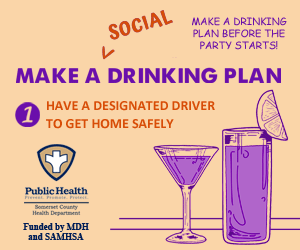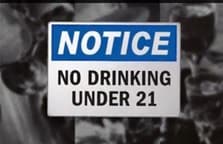 tips training:
tips training:
Training for Intervention Procedures (TIPS) is an alcohol management program approved by the State of Maryland. The purpose of TIPS is to teach servers of alcohol acceptable and helpful standards for responsible alcohol service.
For More Information, Contact:
Somerset County Health Department
443-523-1700
Do you have a social drinking plan?

- Have a designated driver to get home safely! NEVER drink and drive!
- Set a realistic goal for your alcohol use. How much will you drink and still be able to function?
- Alternate alcoholic and non-alcoholic drinks.
- Eat when you drink.
- Agree to help each other make and keep to the plan.
Binge on the truth
It’s no secret that underage and binge drinking are hazardous to not only your health but also to the well-being of anyone around you. Get the facts here on the dangers and consequences of underage and excessive drinking. The more you know, the more you’ll be able to resist peer pressure and stay safe.
get the facts – what is alcohol?
The Centers for Disease Control and Prevention defines alcohol as an intoxicating ingredient found in beer, wine, and liquor (like whiskey, vodka, rum, gin, tequila, etc..). It is produced by the fermentation of yeast, sugars, and starches. Alcohol affects every organ in the body and is a central nervous system depressant that is rapidly absorbed from the stomach and small intestine into the bloodstream. The intensity of the effect of alcohol on the body is directly related to the amount consumed.
What is considered a standard alcohol drink?
While serving sizes can vary, a standard drink contains roughly 14 grams of pure alcohol. This is equal to about 12 ounces of regular beer, 5 ounces of wine, and just half of a single ounce of distilled spirits.
what are the consequences of drinking alcohol?
There is a long list of dangerous outcomes from alcohol consumption, especially from excessive underage drinking. Below are just a few:
• Disruption to the structure and function of still-developing brains
• Increased risk of physical and sexual assault
• Increased risk of sexually transmitted diseases and unplanned pregnancies
• Links to illicit drug use and tobacco use
• Higher likelihood of alcohol dependence later in life
• Development of serious health problems such as stroke, heart and liver disease, and various cancers.
• Behavior that threatens the safety of innocent individuals (drunk driving, violence toward others)
short term effects:
- Dizziness
- Major mood swings
- Violent behavior
- Lack of coordination
- Impaired motor skills
- Impaired judgement
- Nausea and vomiting
- Damage to your short-term memory
long term effects:
- Alcohol addiction
- Depression
- Increased risk of cancer
- Brain damage and memory loss
- Problems getting and keeping a job
- Liver damage, including cirrhosis of the liver
- Relationship and family problems
- Death
How widespread is underage drinking?
Underage alcohol consumption is common in the United States and can have harmful outcomes. A comprehensive approach that includes effective policy strategies can prevent underage drinking and related harms.
Underage drinking is a significant public health problem in the U.S. Excessive drinking is responsible for more than 3,900 deaths and 225,000 years of potential life lost among people under age 21 each year.1 Underage drinking cost the U.S. $24 billion in 2010.2
Underage Drinking is Common
Alcohol is the most commonly used substance among young people in the U.S. Rates of current and binge drinking among high school students have generally been declining in recent decades. Although males historically had higher rates, in 2019, female high school students were more likely to drink alcohol and binge drink than male high school students.4
Underage Drinking is Dangerous
Youth who drink alcohol are more likely to experience4-7
- School problems, such as higher rates of absences or lower grades.
- Social problems, such as fighting or lack of participation in youth activities.
- Legal problems, such as arrest for driving or physically hurting someone while drunk.
- Physical problems, such as hangovers or illnesses.
- Unwanted, unplanned, and unprotected sexual activity.
- Disruption of normal growth or sexual development.
- Physical and sexual violence.
- Increased risk of suicide and homicide.
- Alcohol-related motor vehicle crashes and other unintentional injuries, such as burns, falls, or drowning.
- Memory problems.
- Misuse of other substances.
- Changes in brain development that may have life-long effects.
- Alcohol poisoning.
In general, the risk of youth experiencing these problems is greater for those who binge drink than for those who do not binge drink.6,7
Early initiation of drinking is associated with development of an alcohol use disorder later in life.8
Underage Drinking is Associated with Adult Drinking
Studies show a relationship between underage drinking behaviors and the drinking behaviors of adult relatives, adults in the same household, and adults in the same community and state.
- There is a relationship between youth and adult drinking, including binge drinking, in states and communities.9-11 A 5% increase in binge drinking among adults in a community is associated with a 12% increase in the chance of underage drinking.10
- Among adolescents whose peers drink alcohol, those whose parents binge drink are more likely to drink alcohol than those whose parents do not.12
Underage Drinking is Preventable
State alcohol policy environments influence underage drinking, as well as excessive drinking among adults. Comprehensive approaches that include effective population-level policy strategies can reduce underage drinking.10,13,14 The Community Preventive Services Task Force recommends several effective strategies for preventing excessive drinking,15 including:
- Increasing alcohol taxes.
- Having commercial host (“dram shop”) liability laws.
- Regulating the number and concentration of alcohol outlets.
- Enforcing laws prohibiting alcohol sales to minors.
The Surgeon General’s Report on Alcohol, Drugs, and Health describes other strategies that can complement effective alcohol policies, such as national media campaigns targeting youth and adults, reducing youth exposure to alcohol advertising, and the development of comprehensive community-based programs.5 Read more about the prevention of excessive alcohol use, including underage drinking.
How do I resist peer pressure?
- Say “No” like you mean it. Make eye contact with the person pressuring you and say “NO” firmly. The more definitive you are in your refusal, the less people will bother you.
- Back up a “No” with a positive statement Say something like, “Thanks, but I’m fine right now,” or “I’m okay—I’m having fun anyway.” You don’t need to get defensive, provide a lengthy explanation, or call
- Be repetitive. Don’t hesitate to state your position over and over again if people continue to pressure you. Your decision not to drink is yours alone, and isn’t a statement or judgment on anyone else’s behavior.
- Be your own best friend. Remind yourself every now and then that you’re special and block any negative thoughts about needing to do what others do just so that you can fit in. If your friendships are dependent on doing things you don’t want to do, then seek other friends.
- Find ways to excel. Challenge yourself to do your best. Focus your attention on your personal goals instead of the goals of a group.
others out on their drinking.
How can I get help?
You can dial 2-1-1 to access a wide range of health and human services, including those that can connect you directly to agencies and organizations specializing in underage alcohol and substance abuse situations.

